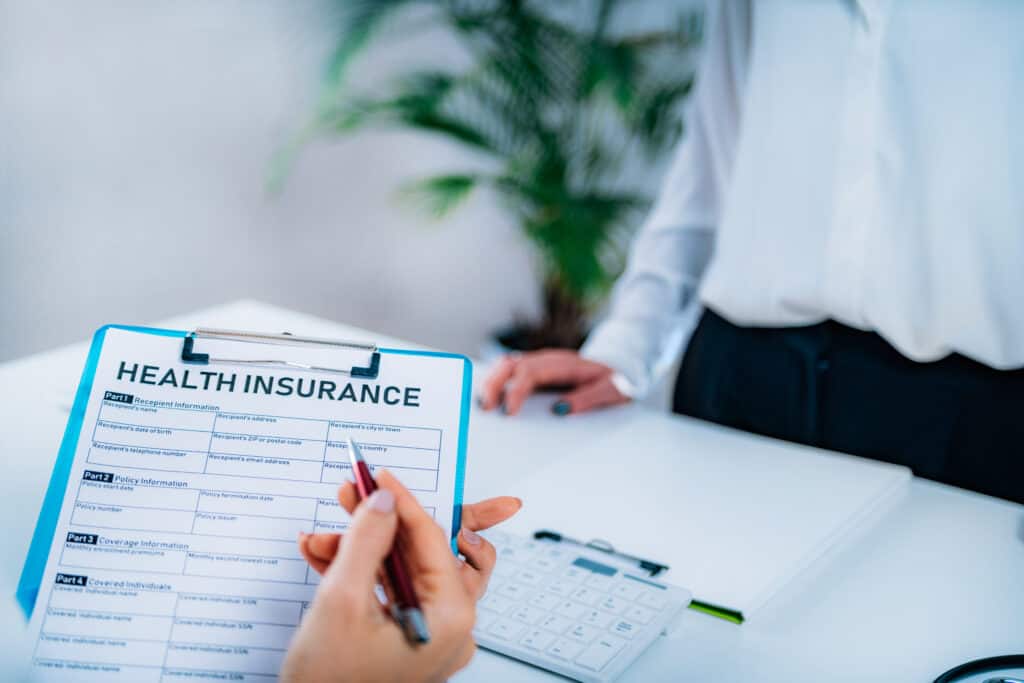Have you recently been injured on the job and now your employer is sending you to the company doctor? You might assume that a company doctor visit implies an accepted claim. However, it’s important to understand the nuances of the workers’ comp process and not jump to conclusions too quickly.
In this article, we will delve into the topic of company doctors and accepted workers’ compensation claims, exploring the factors that come into play and providing you with the information you need to navigate this process effectively.

The purpose of visiting the company doctor is to assess and treat any work-related injuries or illnesses. When an employee is injured or falls ill on the job, it is important for them to seek medical attention as soon as possible. By visiting the company doctor, employees can receive the necessary medical care and treatment specific to their work-related condition.
In addition to providing medical treatment, the company doctor may also be responsible for evaluating the employee’s ability to return to work. They will assess the employee’s condition, functionality, and any work restrictions that may be necessary. This evaluation helps the employer understand the employee’s limitations and make appropriate accommodations if needed.
No! It’s very common for an employer and/or an insurance company to send you to their handpicked doctor in hopes of getting a report from him saying you weren’t really hurt, or that you can work, or some other opinion which is favorable to them. If the doctor says something that they don’t like – expensive evaluations like an MRI or taking you out of work – the defendants turn around and deny your claim. Your employer’s only responsibility is to pay for the authorized visits with this doctor. They have NOT accepted your claim.
If your company or their adjuster is telling you to go to a specific doctor you should ask them if they’ve accepted the claim. This is done on a Form 60 or, if the claim is accepted while they investigate, a Form 63.

The company doctor is responsible for determining the validity of an accepted claim in order to ensure that the employee is eligible for any benefits they are claiming. The company doctor will typically review all medical information provided by the employee as well as any diagnostic tests, such as x-rays, blood tests, and other examinations that have been performed. This helps the doctor to assess the current health status of the employee as it relates to their work-related injury or illness.
The doctor will then make a determination of the severity of the injury or illness and any disability that may be associated with it. They will also provide recommendations on the employee’s ability to return to work and any restrictions that should be in place. This evaluation is ultimately used by the employer, insurance company, and/or workers’ compensation board to determine the validity of the claim.
In conclusion, a visit to the company doctor does not automatically mean that your workers’ compensation claim is accepted. However, it can play an important role in the evaluation process and help ensure that you receive any benefits you are entitled to.
If you have been injured on the job and need help with your workers’ compensation claim, contact Oxner + Permar Law Firm. Our experienced team of attorneys can provide you with the legal advice and representation you need to ensure that your rights are protected and that you receive the maximum benefits available to you.
Are you confused about the difference between a Form 60 and a Form 63 in workers’ compensation? You’re not alone. These two forms can often cause confusion and frustration for employers and employees alike. But fear not, we’re here to break it down for you and help you understand the distinction between these two important documents.
In this article, we will delve into the details of Form 60 and Form 63, explaining their functions, when to use them, and what happens if you do not use the right one. Whether you’re an employer or an employee involved in a workers’ compensation case, this guide will help you understand the difference between these two forms and how to properly utilize them.

These are the two forms which defendants use to accept a claim before the Industrial Commission. A Form 60 is an outright acceptance of the claim. It’s difficult for an insurance company to get off the hook if they’ve filed this. As a result, you are more likely to see an adjuster file a Form 63.
Technically, a Form 63 is supposed to be used if an adjuster isn’t sure if a claim is compensable. They have 90 days to investigate the claim and then deny it if needed. If they take no action within 90 days the claim is accepted. There are two things to look out for. If you have a Form 60 it may be very limited – they are only accepting your low back, not your hips, legs, or upper back for instance.
Additionally, a Form 63 is often misused as a 90-day trial. If your case looks like it’s going to be expensive the claim is going to be denied without regard to the actual facts of how you got hurt. We’ve actually had an adjuster testify to that tactic, under oath, before the Industrial Commission.
Form 60 and Form 63 are two important forms utilized in the workers’ compensation claims process. Each form is used to give information that helps the insurance provider assess whether a claim is valid, and if so what sort of coverage should be provided to the claimant.
Both Form 60 and Form 63 play a vital role in the claims process as they provide essential information to the workers’ compensation insurance carrier. The information collected on these forms helps the insurance carrier determine the compensability of the claim, the extent of the injury, and the appropriate benefits to be provided to the injured employee.
Accurate and timely completion of these forms is crucial for a smooth claims process. Any discrepancies or incomplete information can lead to delays or denials of the claim. It is important for both the employer and the employee to understand the significance of these forms and ensure that they are completed accurately and submitted promptly.

Using the wrong form in Workers’ Compensation can have legal implications and consequences. Both Form 60 and Form 63 are important documents that serve different purposes in the workers’ compensation process. Failing to use the correct form can result in delays, potential legal issues, and even financial penalties.
Insurance companies may also question the validity of the claim or deny it altogether, leading to prolonged disputes and potential legal battles. Additionally, regulatory authorities may impose penalties for non-compliance with the proper reporting procedures.
To avoid these legal implications and consequences, it is essential to familiarize yourself with the specific requirements and guidelines for reporting work-related injuries or illnesses in your jurisdiction. Consulting with legal professionals or experts in workers’ compensation can provide valuable guidance in understanding the correct forms to use and ensuring compliance with the necessary procedures.
To make sure that you will be filling out Forms 60 and 63, as well as any other related forms, correctly and in a timely manner, Oxner + Permar Law would be happy to help you. Contact us today for a free consultation.
If you’ve ever been injured on the job, you may have heard the term “Form 18” thrown around. But what exactly is a Form 18 and what is so important about a Form 18 in workers’ compensation? In this article, we will delve into the details of a Form 18, discussing its purpose, components, and why it is crucial for both employees and employers in the workers’ compensation process.

The Form 18 is a crucial document in the realm of Workers’ Compensation. This form serves as the initial notice of an employee’s intent to file a workers’ compensation claim. It is essentially the first step in the process of seeking compensation for work-related injuries or illnesses.
The Form 18 includes important information such as the employee’s personal details, the date and time of the injury, a description of the incident, and any witnesses present. It is crucial to provide accurate and detailed information in the Form 18 to ensure a smooth and successful claims process.
Once the Form 18 is submitted, it initiates the workers’ compensation claim process. The employer or their insurance carrier will review the form and investigate the incident to determine the validity of the claim. They may request additional documentation or evidence to support the claim, such as medical records or witness statements.
A Form 18 is the form you use to formally open a file at the Industrial Commission. Just because your employer or the adjuster is sending you to a doctor doesn’t mean they’ve accepted the claim. And it doesn’t mean you have a claim on file with the Industrial Commission. More often than you’d think an injured worker reports their claim to their employer, gets some medical treatment, and returns to work.
After a while the injury is acting up and bothering them but when they try to go back to the doctor their adjuster denies the claim saying that a Form 18 was not timely filed with the Industrial Commission. The fact that everyone “knew” about the claim doesn’t always make a difference. The Industrial Commission needs that Form 18. This is the only irrefutable way to have a claim established.

When completing a Form 18 in Workers’ Compensation, it is crucial to avoid common mistakes that could potentially lead to delays, denials, or complications in the claim process. Here are some of the most common mistakes to avoid:
One of the biggest mistakes is failing to provide complete and accurate information on the Form 18. This includes details such as the injured employee’s name, date of injury, description of the injury, and the employer’s information. Any missing or incorrect information can lead to delays or even rejection of the claim.
It is important to accurately classify the type of injury on the Form 18. This includes specifying whether it is a specific injury, an occupational disease, or an aggravation of a pre-existing condition. Misclassifying the injury can lead to complications in the claim process and may result in the denial of benefits.
Timeliness is crucial when it comes to reporting a work-related injury. Failing to report the injury within the specified timeframe can result in the denial of benefits. It is important to understand the specific reporting requirements and ensure that the Form 18 is submitted promptly.
When completing a Form 18, it is essential to provide supporting documentation to strengthen the claim. This may include medical records, witness statements, incident reports, and any other relevant evidence. Failing to include these documents or providing incomplete documentation can weaken the claim and may result in a denial of benefits.
Workers’ Compensation laws can be complex, and navigating the claim process can be challenging. It is advisable to seek legal advice from an experienced attorney who specializes in Workers’ Compensation cases. They can guide you through the process, help you avoid common mistakes, and ensure that your rights are protected.
If you want to know more on what is so important about Form 18, Oxner + Permar Law Firm can help. Our experienced attorneys understand the nuances of Workers’ Compensation laws in North Carolina and can assist you with filing your claim and ensuring that all applicable deadlines are met. Contact us today for more information.
Has your employer ever asked you to file your claim on your health insurance? At first, it might seem like a convenient way to handle medical expenses, but there could be some hidden pitfalls. It’s essential to understand the potential consequences before blindly following your employer’s instructions.
So, before you submit that claim form, let’s dive into the details and uncover what could be wrong with your employer’s suggestion.

Here’s a great “lawyer answer” … it depends. What we worry about is when an employer tries to avoid telling their workers’ compensation carrier about a claim. It’s sort of like getting into a fender bender in a parking lot. You may be tempted to pay the other guy $500 to get his car fixed and keep everyone’s insurance company out of it. While that works with dents on fenders it’s not so clear that it works with internal injuries on workers.
If it gets you medical treatment more quickly and efficiently than waiting around for an adjuster, we’re all in favor of putting the bill on health insurance. But if your boss isn’t reporting the claim to the adjuster this could be a big problem. We’ve seen it happen dozens of times: when the doctor takes you out of work you’ve got no income coming in. You chase down a workers’ compensation adjuster who in turn chases down your employer and asks why this wasn’t immediately turned in for handling. At that point your boss can admit he tried to handle it in house. Or he can blame you for everything.
Sadly, we’ve seen a lot of injured workers get the short end of a stick just because they tried to help the company out. You really need to think this through carefully. Our rule of thumb is that it is usually fine if it speeds up treatment and it’s your idea. We’re less thrilled by it when the employer is telling you to do it right off the bat.
There could be several reasons why employers ask employees to file claims on their health insurance. Firstly, it could be a matter of convenience for the employer. By having employees file their own claims, the employer can save time and resources that would otherwise be spent on administrative tasks related to insurance claims.
Additionally, employers may ask employees to file claims as a way to empower them and give them more control over their healthcare. By taking responsibility for their own claims, employees can choose the healthcare providers and services that best meet their needs, rather than relying solely on recommendations or restrictions imposed by the employer.
However, it’s important for employees to understand their rights and responsibilities when it comes to filing claims. They should ensure that they are aware of the specific procedures and requirements set by their health insurance provider and that they have all the necessary documentation and information to submit a claim accurately.
In some cases, employers may ask employees to file claims in order to shift some of the financial burden onto the employee. This could be a cost-saving measure for the employer, but it may also place a greater financial strain on the employee. It’s important for employees to carefully review their insurance policies and understand their coverage and any potential out-of-pocket expenses.
If an employee feels uncomfortable or unsure about filing a claim on their health insurance, it is advisable for them to consult with their human resources department or seek guidance from an insurance professional. It’s important to ensure that all claims are filed correctly and that employees receive the appropriate benefits and coverage they are entitled to under their health insurance plan.

Handling a situation where your employer asks you to file unauthorized claims can be challenging, but it’s important to navigate it carefully to protect your integrity and avoid any legal or ethical issues. Here are some steps you can take to handle this situation:
Familiarize yourself with your health insurance policy and its terms and conditions. This will help you identify any discrepancies between what your employer is asking you to do and what is allowed under the policy.
Have a conversation with your employer to clarify their request and express your concerns. Politely explain that filing unauthorized claims can have negative consequences, both for you and the company. Try to understand their perspective and see if there is a valid reason behind their request.
If you believe that your employer’s request is illegal or unethical, it may be wise to consult with an employment lawyer. They can provide guidance on your rights and potential legal ramifications.
At Oxner + Permar Law, we understand the complexities of employment law and can provide advice and guidance to help protect your rights as an employee. If your employer is asking you to file your claim on your health insurance and you believe that it is unauthorized, contact us today for a free consultation.
Are you not sure if your employer has workers’ compensation insurance? It’s a valid concern, especially if you work in a high-risk industry where accidents and injuries are more likely to occur. Knowing whether your employer has this insurance can give you peace of mind and assurance that you will be protected in case of an accident on the job.
So, if you have any doubts or concerns about your employer’s workers’ compensation insurance, keep reading to learn how to find out the truth and ensure that you are adequately protected in the workplace.

There are several signs that may indicate that your employer does not have workers’ compensation insurance. It is important to be aware of these signs to protect your rights and ensure that you are covered in case of a workplace injury. Here are some signs to look out for:
If your employer does not provide any information or documentation regarding workers’ compensation insurance, it could be a red flag. Employers are typically required to display a notice or provide information about workers’ compensation coverage in the workplace.
If your employer discourages or prevents you from reporting workplace injuries, it could be a sign that they do not have workers’ compensation insurance. Employers who lack coverage may try to avoid liability and expenses associated with workplace injuries.
If you or your coworkers have experienced difficulties in receiving compensation for work-related injuries, it could indicate that your employer does not have workers’ compensation insurance. Delayed or denied claims may be a tactic used by uninsured employers to avoid paying for medical expenses and lost wages.
Employers without workers’ compensation insurance may be less inclined to prioritize workplace safety. If your employer consistently fails to implement safety measures or neglects to provide proper training and equipment, it could be a sign that they do not have insurance coverage.
Employers who do not have workers’ compensation insurance may frequently hire and terminate employees to avoid potential claims. If you notice a high turnover rate or irregular employment practices within your workplace, it could be an indication that your employer is trying to avoid providing workers’ compensation benefits.
Call us. We can help track this down. Every employer is required to advise the Industrial Commission of this although many do not. Smaller companies are prone to skipping this and certain business types like construction, home health agencies, and small trucking companies seem to neglect this as well. By law they are all required to keep that information posted where all employees can see it regularly. Any employer who has three or more employees regularly working is required to carry workers’ compensation insurance.
If your employer is making it difficult to find out who their carrier is, you may well have a problem on your hands. It certainly suggests that they aren’t keen on complying with North Carolina law. And that makes your situation all the more precarious.

Once you have confirmed that your employer does not have workers’ compensation insurance, it is important to take certain steps to protect yourself and ensure that you are not left without coverage in the event of an injury or accident at work.
Make sure to keep a record of any incidents or injuries that occur at work, including dates, times, and details of the incident. This documentation will be important if you need to file a claim or take legal action in the future.
It is highly recommended to seek the advice of an experienced workers’ compensation attorney. They can guide you through the process, explain your rights, and help you determine the best course of action to obtain the compensation you deserve.
If your employer does not have workers’ compensation insurance, it is crucial to report the situation to the appropriate authorities. Contact your local workers’ compensation board or state labor department to report the lack of insurance. They will be able to provide guidance on what steps to take next.
If you sustain an injury at work, seek medical treatment as soon as possible. Even without workers’ compensation insurance, you have the right to receive necessary medical care. Keep all related medical records and bills to support any future claims or legal action.
In the absence of workers’ compensation insurance, you may need to consider alternative options for financial support. This could include pursuing a personal injury lawsuit against your employer or looking into disability benefits or other programs that you may be eligible for.
Oxner + Permar Law has experience handling cases involving employers without workers’ compensation insurance. Our team of knowledgeable attorneys can help you understand your rights and fight for the compensation you deserve. Contact us today for a free consultation.